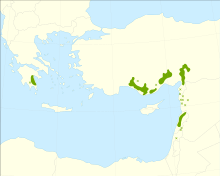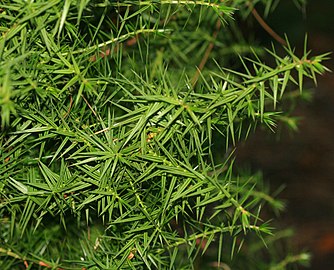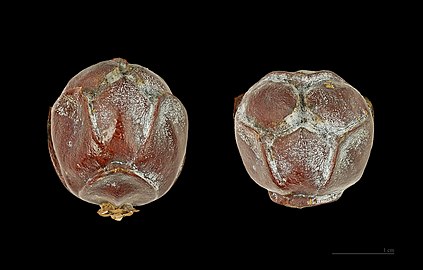Juniperus drupacea
| Juniperus drupacea | |
|---|---|

| |
| Specimen in Madrid, Spain | |
| Scientific classification | |
| Kingdom: | Plantae |
| Clade: | Tracheophytes |
| Clade: | Gymnospermae |
| Division: | Pinophyta |
| Class: | Pinopsida |
| Order: | Cupressales
|
| Family: | Cupressaceae |
| Genus: | Juniperus |
| Section: | Juniperus sect. Caryocedrus
|
| Species: | J. drupacea
|
| Binomial name | |
| Juniperus drupacea Labill. | |

| |
| Natural range | |
Juniperus drupacea, the Syrian juniper, is a species of
Description
Juniperus drupacea is the tallest species of juniper, forming a conical
The seed cones are the largest of any juniper, berry-like but hard and dry, green ripening in about 25 months to dark purple-brown with a pale blue waxy coating; they are ovoid to spherical, 20–27 mm (3⁄4–1 in) long and 20–25 mm diameter, and have six or nine fused scales in 2–3 whorls, each scale with a slightly raised apex. The three apical scales each bear a single seed, but with the three seeds fused together into a single nut-like shell. The male cones are produced in clusters (unlike any other juniper) of 5–20 cones together, yellow, 3–4 mm long, and fall soon after shedding their pollen in early spring.
Taxonomy
Because of its distinct cones with the seeds fused three together and the clustered male cones, it has sometimes been treated in a distinct genus of its own as Arceuthos drupacea (Labill.) Antoine & Kotschy, but genetic studies have shown it is fairly closely related to J. macrocarpa and J. oxycedrus.
References
- . Retrieved 19 November 2021.
- ^ Adams, Robert P. & Schwarzbach, Andrea E. (2013). "Phylogeny of Juniperus using nrDNA and four cpDNA regions" (PDF). Phytologia. 95 (2): 179–187. Retrieved 2022-04-22.
- S2CID 227182680.
- PMID 35967253.




